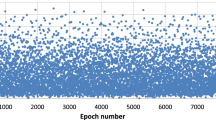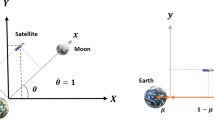Abstract
The so-called highly reduced-dynamic (HRD) orbit determination strategy and its use for the determination of the Earth’s gravitational field are analyzed. We discuss the functional model for the generation of HRD orbits, which are a compromise of the two extreme cases of dynamic and purely geometrically determined kinematic orbits. For gravity field recovery the energy integral approach is applied, which is based on the law of energy conservation in a closed system. The potential of HRD orbits for gravity field determination is studied in the frame of a simulated test environment based on a realistic GOCE orbit configuration. The results are analyzed, assessed, and compared with the respective reference solutions based on a kinematic orbit scenario. The main advantage of HRD orbits is the fact that they contain orbit velocity information, thus avoiding numerical differentiation on the orbit positions. The error characteristics are usually much smoother, and the computation of gravity field solutions is more efficient, because less densely sampled orbit information is sufficient. On the other hand, the main drawback of HRD orbits is that they contain external gravity field information, and thus yield the danger to obtain gravity field results which are biased towards this prior information.
Similar content being viewed by others
References
Badura T., 2006. Gravity Field Analysis from Satellite Orbit Information applying the Energy Integral Approach. PhD Thesis, Graz University of Technology, Graz, Austria.
Badura T., Sakulin C., Gruber C. and Klostius R., 2006. Derivation of the CHAMP-only global gravity field model TUG-CHAMP04 applying the energy integral approach. Stud. Geophys. Geod., 50, 59–74.
Beutler G., 2005. Methods of Celestial Mechanics. Springer, Berlin.
Beutler G., Jäggi A., Hugentobler U. and Mervart L., 2006. Efficient satellite orbit modelling using pseudo-stochastic parameters. J. Geodesy, 80, 353–372.
Bock H., Jäggi A., Švehla D., Beutler G., Hugentobler U. and Visser P., 2007. Precise orbit determination for the GOCE satellite using GPS. Adv. Space Res., 39, 1638–1647.
Dach R., Hugentobler U., Fridez P. and Meindl M. (Eds.), 2007. Bernese GPS Software Version 5.0. Astronomical Institute, University of Bern, Bern, Switzerland.
Ditmar P., Kuznetsov V., van Eck van der Sluijs A.A., Schrama E. and Klees R., 2006. ’DEOS_CHAMP_01C_70’: a model of the Earth’s gravity field computed from accelerations of the CHAMP satellite. J. Geodesy, 79, 586–601.
ESA, 1999. Gravity Field and Steady-State Ocean Circulation Explorer Mission. Reports for Mission Selection. The Four Candidate Earth Explorer Core Missions, SP-1233(1), European Space Agency, Noordwijk, The Netherlands.
Földváry L., Švehla D., Gerlach C., Wermuth M., Gruber T., Rummel R., Rothacher M., Frommknecht B., Peters T. and Steigenberger P., 2004. Gravity model TUM-2Sp based on the energy balance approach and kinematic CHAMP orbits. In: Reigber C., Lühr H., Schwintzer P. and Wickert J. (Eds.), Earth Observation with CHAMP-Results from Three Years in Orbit, Springer Verlag, Heidelberg, Berlin, New York, 13–18.
Gerlach C., Földváry L., Švehla D., Gruber T., Wermuth M., Sneeuw N., Frommknecht B., Oberndorfer H., Peters T., Rothacher M., Rummel R. and Steigenberger P., 2003. A CHAMP-only gravity field model from kinematic orbits using the energy integral. Geophys. Res. Lett., 30, Art.No.2037.
Goiginger H. and Pail R., 2007. Investigation of velocities derived from satellite positions in the framework of the energy integral approach. In: Fletcher K. (Ed.), Proceedings of the 3 rd International GOCE User Workshop, ESA Special Publication SP-627, ISBN 92-9092-938-3, European Space Agency, Noordwijk, The Netherlands, 319–324.
GRACE, 1998. Gravity Recovery and Climate Experiment: Science and Mission Requirements Document. Revision A. JPLD-15928, NASA’s Earth System Science Pathfinder Program, Jet Propulsion Laboratory, Pasadena, CA.
Ilk K.-H., 2002. Energy relations for the motion of two satellites within the gravity field of the Earth. In: Sideris M.G. (Ed.), Gravity, Geoid and Geodynamics 2000. International Association of Geodesy Symposia, 123, Springer-Verlag, Berlin, 129–135.
Jäggi A., Hugentobler U. and Beutler G., 2005. Efficient stochastic orbit modeling techniques using leaast squares estimators. In: Sansò F. (Ed.), A Window on the Future of Geodesy. International Association of Geodesy Symposia, 128, Springer-Verlag, Berlin, 175–180.
Jäggi A., 2006. Pseudo-Stochastic Orbit Modeling of Low Earth Satellites Using the Global Positioning System. PhD Thesis, Astronomical Institute, University of Bern, Bern, Switzerland.
Jäggi A., Beutler G., Bock H. and Hugentobler U., 2007. Kinematic and highly reduced-dynamic LEO orbit determination for gravity field estimation. In: Tregoning P. and Rizos C. (Eds.), Dynamic Planet-Monitoring and Understanding a Dynamic Planet with Geodetic and Oceanographic Tools. International Association of Geodesy Symposia, 130, Springer-Verlag, Berlin, 354–361.
Jekeli C., 1999. The determination of gravitational potential differences from satellite-to-satellite tracking. Celest. Mech. Dyn. Astron., 75, 85–101.
Montenbruck O. and Gill E., 2000. Satellite Orbits-Models, Methods and Applications. Springer-Verlag, Berlin, Germany.
O’Keefe J.A., 1957. An application of Jacobi’s integral to the motion of an Earth satellite. Astron. J., 62, 265–266.
Mayer-Gürr T., Ilk K.H., Eicker A. and Feuchtinger M., 2005. ITG-CHAMP01: a CHAMP gravity field model from short kinematic arcs over a one-year observation period. J. Geodesy, 78, 462–480.
Migliaccio R., Reguzzoni M. and Sansó F., 2003. Spacewise approach to satellite gravity field determination in the presence of coloured noise. J. Geodesy, 78, 304–313.
Pail R., Metzler B., Preimesberger T., Goiginger H., Mayrhofer R., Höck E., Schuh W.-D., Alkathib H., Boxhammer C., Siemes C. and Wermuth M., 2007. GOCE-Schwerefeldprozessierung: Software-Architektur und Simulationsergebnisse. Zeitschrift für Geodäsie, Geoinformation und Landmanagement, Heft 1/2007, Deutscher Verein f. Vermessungswesen e.V., 16–25.
Prange L., Jäggi A., Beutler G., Mervart L. and Dach R., 2008. Gravity field determination at the AIUB-the celestial mechanics approach. In: International Association of Geodesy Symposia, Springer-Verlag, Berlin (in print).
Reigber C., Schwintzer P. and Lühr H., 1999. CHAMP geopotential mission. Boll. Geof. Teor. Appl., 40, 285–289.
Reigber C., Schwintzer P., Neumayer K.-H., Barthelmes F., König R., Förste C., Balmino G., Biancale R., Lemoine J.-M., Loyer S., Bruinsma S., Perosanz F. and Fayard T., 2007. The CHAMP-only Earth gravity field model EIGEN-2. Adv. Space Res., 31, 1883–1888.
Rummel R., Gruber T. and Koop R., 2004. High level processing facility for GOCE: products and processing strategy. GOCE, the Geoid and Oceanography, Proceedings of the 2nd International GOCE User Workshop. ESA Special Publication SP-569, ISBN 92-9092-880-8, European Space Agency, Noordwijk, The Netherlands.
Švehla D. and Rothacher M., 2002. Kinematic and reduced-dynamic precise orbit determination of low Earth orbiters. Adv. Geosci., 1, 47–56.
Wu S.C., Yunck T.P. and Thornton C.L., 1991. Reduced-dynamic technique for precise orbit determination of low Earth satellites. J. Guid. Control Dyn., 14, 24–30.
Visser P.N.A.M., Sneeuw N. and Gerlach C., 2003. Energy integral method for gravity field determination from satellite orbit coordinates. J. Geodesy, 77, 207–216.
Author information
Authors and Affiliations
Corresponding author
Rights and permissions
About this article
Cite this article
Jäggi, A., Bock, H., Pail, R. et al. Highly-reduced dynamic orbits and their use for global gravity field recovery: A simulation study for GOCE. Stud Geophys Geod 52, 341–359 (2008). https://doi.org/10.1007/s11200-008-0025-z
Received:
Revised:
Accepted:
Published:
Issue Date:
DOI: https://doi.org/10.1007/s11200-008-0025-z




